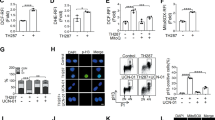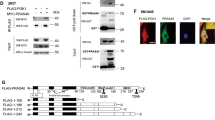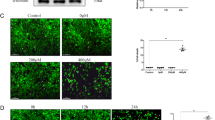Abstract
Caspase 3 is an essential factor for Fas-mediated cell death and exists endogenously in cells where its activation is suppressed by p21 and ILP. Inside the cell, procaspase 3 interacts with p21 on mitochondria. In the present study, we investigated the molecular basis for procaspase 3/p21 complex formation. During Fas-mediated cell death, mitochondria are damaged, accompanied by decreased mitochondrial membrane-potential and decreased intracellular ATP levels. This mitochondrial damage occurs before an estrangement of the procaspase 3/p21 complex, and we demonstrate that intracellular ATP-deprivation also initiates an estrangement of procaspase 3/p21 complex formation and accelerates Fas-mediated cell death. In addition, our current results revealed that the phosphorylated p21 by PKA interacts with procaspase 3. Here, we report that the mitochondrial role, especially for ATP synthesis, and PKA are necessary for the procaspase 3/p21 complex formation to resist Fas-mediated cell death. Cell Death and Differentiation (2000) 7, 721–728
Similar content being viewed by others
Log in or create a free account to read this content
Gain free access to this article, as well as selected content from this journal and more on nature.com
or
Abbreviations
- adenosine triphosphate:
-
ATP
- protein kinase A:
-
PKA
- agonistic anti-human Fas antibody CH-11 clone:
-
Fas Ab
- 5′-p-fluorosulfonylbenzoyl adenosine:
-
FSBA
References
Wyllie AH, Kerr JFR and Currie AR . (1980) Cell death: The significance of apoptosis. Int. Rev. Cytol. 68: 251–306
Nagata S . (1997) Apoptosis by death factor. Cell 88: 355–365
Nagata S and Golstein P . (1995) The Fas death factor. Science 267: 1449–1456
Alnemri ES, Livingston DJ, Nicholson DW, Salvesen G, Thornbery NA, Wong WW and Yuan J . (1996) Human ICE/CED-3 protease nomenclature. Cell 87: 171
Hasegawa J, Kamada S, Kamiike W, Shimizu S, Imazu T, Matsuda H and Tsujimoto Y . (1996) Involvement of CPP32/Yama(-like) proteases in Fas-mediated apoptosis. Cancer Res. 56: 1713–1718
Suzuki A, Iwasaki M and Wagai N . (1997) Involvement of cytoplasmic serineproteinase and CPP32 subfamily in the molecular machinery of caspase 3 activation during Fas-mediated apoptosis. Exp. Cell. Res. 233: 48–55
Muzio M, Chinnaiyan AM, Kischkel FC, O'Rourke K, Shevchenko A, Ni J, Scaffidi C, Bretz JD, Zhang M, Gentz R, Mann M, Krammer PH, Peter ME and Dixit VM . (1996) FLICE, a novel FADD-homologous ICE/CED-3-like protease, is recruited to the CD95 (Fas/APO-1) death-inducing signaling complex. Cell 85: 817–827
Boldin MP, Goncharov TM, Golstev YV and Wallach D . (1996) Involvement of MACH, a novel MORT-1/FADD-interacting protease, in Fas/APO-1 and TNF receptor-induced cell death. Cell 85: 803–815
Thornbery NA, Rano TA, Peterson EP, Rasper DM, Timkey T, Garcia-Calvo M, Houtzager VM, Nordstorm PA, Roy S, Vaillancourt JP, Chapman KT and Nicholson DW . (1997) A combinatorial approach defined specifities of members of the caspase family and granzyme B: Functional relationships established for key mediators of apoptosis. J. Biol. Chem. 272: 17907–17911
Suzuki A, Tsutomi Y, Akahane K, Araki T and Miura M . (1998) Resistance to Fas-mediated apoptosis: Activation of caspase 3 is regulated by cell cycle regulator p21WAF1 and IAP gene family ILP. Oncogene 17: 931–940
Suzuki A, Tsutomi Y, Miura M and Akahane K . (1999) Caspase 3 inactivation to suppress Fas-mediated apoptosis: Identification of binding domain with p21 and ILP, and inactivation machinery by p21. Oncogene 18: 1239–1244
Suzuki A, Tsutomi Y, Yamamoto N, Shibutani T and Akahane K . (1999) Mitochondrial regulation of cell death: Mitochondria are essential for procaspase 3/p21 complex formation to resist Fas-mediated cell death. Mol. Cell. Biol. 19: 3842–3847
Duckett CS, Nava VE, Gedrich RW, Clem RJ, Dongen JLV, Gilfillan MC, Shiels H, Hardwick JM and Thompson CB . (1996) A conserved family of cellular genes related to the baculovirus iap gene and encoding apoptosis inhibitors. EMBO J. 15: 2685–2694
Deveraux QL, Takahashi R, Salvesen GS and Reed JC . (1997) X-linked IAP is a direct inhibitor of cell death proteases. Nature 388: 300–304
Peso L, Gonzalez-Garcia M, Page C, Herrera R and Nunez G . (1997) Interleukin-3-induced phosphorylation of BAD through protein kinase Akt. Science 278: 687–689
Datta SR, Dudek H, Tao X, Masters S, Fu H, Gotoh Y and Greenberg ME . (1997) Akt phosphorylation of Bad couples survival signals to the cell-intrinsic death machinery. Cell 91: 231–241
Cardone MH, Roy N, Stennicke HR, Salvesen GS, Franke TF, Stanbridge E, Frisch S and Reed JC . (1998) Regulation of cell death protease caspase-9 by phosphorylation. Science 282: 1318–1321
Harada H, Becknell B, Wilm M, Mann M, Huang LJ, Taylor SS, Scott JD and Korsmeyer SJ . (1999) Phosphorylation and inactivation of BAD by mitochondria-anchored protein kinase A. Mol. Cell. 3: 413–422
Green DR and Reed JC . (1998) Mitochondria and apoptosis. Science 281: 1309–1312
Shimizu S, Eguchi Y, Kamiike W, Waguri S, Uchiyama Y, Matsuda H and Tsujimoto Y . (1996) Bcl-2 blocks loss of mitochondrial membrane potential while ICE inhibitors act at a different step during inhibition of death induced by respiratory chain inhibitors. Oncogene 13: 21–29
Margulis L . (1975) Symbiotic theory of the origin of eukaryotic organelles; criteria for proof. Symp. Soc. Exp. Biol. 29: 21–38
Desjardins P, Frost E and Morais R . (1985) Ethidium bromide-induced loss of mitochondrial DNA from primary chicken embryo fibroblasts. Mol. Cell. Biol. 5: 1163–1169
King MP and Attardi G . (1989) Human cells lacking mtDNA: Repopulation with exogenous mitochondria by complementation. Science 246: 500–503
Jacobson MD, Burne JF, King MP, Miyashita T, Reed JC and Raff MC . (1993) Bcl-2 blocks apoptotis in cells lacking mitochondrial DNA. Nature 361: 365–369
Zou H, Henzel WJ, Liu X, Lutschg A and Wang X . (1997) Apaf-1, a human protein homologous to C. elegans CED-4, participates in cytochrome c-dependent activation of caspase-3. Cell 90: 405–413
Liu X, Kim CN, Yang J, Jemmerson R and Wang X . (1996) Induction of apoptotic program in cell-free extracts: Requirement for dATP and cytochrome c. Cell 86: 147–157
Fadok VA, Voelker DR, Campbell PA, Cohen JJ, Bratton DL and Henson PM . (1992) Exposure of phosphatidylserine on the surface of apoptotic lymphocytes triggers specific recognition and removal by macrophages. J. Immunol. 148: 2207–2216
Mower Jr DA, Peckham DW, Illera VA, Fishbaugh JK, Stunz LL and Ashman RF . (1994) Decreased membrane phospholipid packing and decreased cell size precede DNA cleavage in mature mouse B cell apoptosis. J. Immunol. 152: 4832–4842
Martin SJ, Reutelingsperger CP, McGahon AJ, Rader JA, van Schie RC, LaFace DM and Green DR . (1995) Early redistribution of plasma membrane phosphatidylserine is a general feature of apoptosis regardless of the initiating stimulus: inhibition by overexpression of Bcl-2 and Abl. J. Exp. Med. 182: 1545–1556
Zhuang J, Ren Y, Snowden RT, Zhu H, Gogvadze V, Savill JS and Cohen GM . (1998) Dissociation of phagocyte recognition of cells undergoing apoptosis from other features of the apoptotic program. J. Biol. Chem. 273: 15628–15632
Eguchi Y, Srinivasan A, Tomaselli KJ, Shimizu S and Tsujimoto Y . (1999) ATP-dependent steps in apoptotic signal transduction. Cancer Res. 59: 2174–2181
Yuan J and Horvitz HR . (1992) The Caenorhabditis elegans cell death gene ced-4 encodes a novel protein and is expressed during the period of extensive programmed cell death. Development 116: 309–320
Kanuka H, Hisahara S, Sawamoto K, Shoji S, Okano H and Miura M . (1999) Proapoptotic activity of Caenorhabditis elegans CED-4 protein in Drosphila: Implicated mechanism for caspase activation. Proc. Natl. Acad. Sci. USA 96: 145–150
Kennedy SG, Wagner AJ, Conzen SD, Jordan J, Bellacosa A, Tsichlis PN and Hay N . (1997) The PI 3-kinase/Akt signaling pathway delivers an anti-apoptotic signal. Genes Dev. 11: 701–713
Ahmed NN, Grimes HL, Bellacosa A, Chang TO and Tsichlis PN . (1997) Transduction of interleukin-2 antiapoptotic and proliferative signals via Akt protein kinase. Pro. Natl. Acad. Sci. USA 94: 3627–3632
Hill HD and Sraka J . (1988) Protein determination using bicinchoninic acid in the presence of sulfhydryl reagents. Anal. Biochem. 170: 203–208
Smith PK, Krohn RI, Hermanson GT, Mallia AK, Gartner FH, Provenzano MD, Fujimoto EK, Goeke NM, Olson BJ and Klenk DC . (1985) Measurement of protein using bicinchoninic acid. Anal. Biochem. 170: 203–208
Suzuki A, Iwasaki M, Kato M and Wagai N . (1997) Sequential operation of ceramide synthesis and ICE cascade in CPT-11-initiated apoptotic death signaling. Exp. Cell Res. 233: 41–47
Yonehara S, Ishii A and Yonehara M . (1989) A cell killing monoclonal antibody (anti-Fas) to a cell surface antigen co-downregulated with the receptor of tumor necrosis factor. J. Exp. Med. 169: 1747–1756
Acknowledgements
We thank Dr. Yoshihide Tsujimoto, Osaka University Medical School, for human hepatoma HepG2 cells, and Dr. Masayuki Miura, Osaka University of Medical School, for his valuable discussions. The preparation of this manuscript was supported by the Idest Inc., Edmond, OK, USA.
Author information
Authors and Affiliations
Corresponding author
Additional information
Edited by P Golstein
Rights and permissions
About this article
Cite this article
Suzuki, A., Kawano, H., Hayashida, M. et al. Procaspase 3/p21 complex formation to resist Fas-mediated cell death is initiated as a result of the phosphorylation of p21 by protein kinase A. Cell Death Differ 7, 721–728 (2000). https://doi.org/10.1038/sj.cdd.4400706
Received:
Revised:
Accepted:
Published:
Issue date:
DOI: https://doi.org/10.1038/sj.cdd.4400706
Keywords
This article is cited by
-
Network-informed discovery of multidrug combinations for ERα+/HER2-/PI3Kα-mutant breast cancer
Cellular and Molecular Life Sciences (2023)
-
Part II—mechanism of adaptation: A549 cells adapt to high concentration of nitric oxide through bypass of cell cycle checkpoints
Tumor Biology (2014)
-
Cytoplasmic p21 induced by p65 prevents doxorubicin-induced cell death in pancreatic carcinoma cell line
Journal of Biomedical Science (2012)
-
Armoring CRAds with p21/Waf-1 shRNAs: the next generation of oncolytic adenoviruses
Cancer Gene Therapy (2010)
-
Extracellular adenosine induces apoptosis in Caco-2 human colonic cancer cells by activating caspase-9/-3 via A2a adenosine receptors
Journal of Gastroenterology (2009)



